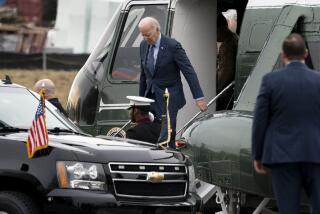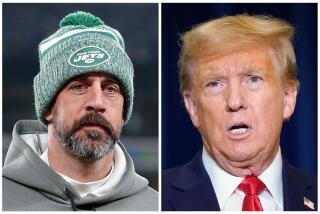Private Lives and Public Prying
- Share via
Every move you make,
Every step you take,
I’ll be watching you.
These lyrics from the Police’s 1983 song “Every Breath You Take” are especially applicable at a time when the news media and snoops have become nearly interchangeable, if not synonymous.
Democracy works in unison with an informed citizenry, and citizens can make enlightened decisions only if exposed to diverse information about a broad array of topics. In effect, then, a free press is a means to retaining democracy, a rung on a ladder. It’s when that means becomes the end--when the public’s right to know is used as justification for the media gratuitously abusing individual members of the public--that trouble arises.
What should we know, and when should we know it? The answers are not chiseled in stone.
If documented information about the private lives of political candidates is helpful to voters--the operative word being documented --then that information should be reported, even if on the surface it seems merely titillating. Whether it’s Arkansas Gov. Bill Clinton in 1992 or Gary Hart in 1988, well-sourced information about a candidate’s extramarital social life could reflect his attitudes about women, for example, and exposing that fact would make for a smarter electorate. So, if it is solid, put it in print, put it on the air. After all, candidates are asking for our trust, making them accountable to us.
Arthur Ashe and Linda Ellerbee, on the other hand, owe us nothing.
Is America now smarter having learned that Ashe has AIDS or that Ellerbee recently had a double mastectomy? Are our lives somehow enriched by having their private pain exposed to leering public scrutiny? Does whatever public good that resulted from their disclosures--and none immediately comes to mind--outweigh the wrongs done to them? Hardly.
Both Ashe and Ellerbee came forward reluctantly, separately revealing intimate details about their health only, they said, after being faced with exposure by the newspaper USA Today. Feeling he had no other alternative, Ashe called a news conference (which was televised) so that he could make the announcement himself. Ellerbee’s story came out in USA Today, after which she elaborated on it in a “PrimeTime Live” interview with her friend, Sylvia Chase.
“I wanted to get the information out on my own right,” Ellerbee told Chase on ABC last Thursday night. With the tabloid spirit appearing to grow inside even legitimate journalism these days like a bulbous tumor, fat chance.
The right to privacy may be difficult to define but, in most cases, responsible journalists should know it when they see it.
Although Ashe’s days as a tennis champion are well behind him, his occasional work as a tennis commentator on TV gives him a quasi-celebrity status. And Ellerbee has remained in the public eye as an author, journalist and TV personality. But does being famous automatically make one raw meat to be fed to media carnivores, who then regurgitate these morsels for the masses like predators feeding their young?
The famous have always had to coexist with media intrusiveness; it’s an unavoidable condition. Yet even public figures should be allowed at least some fissures of privacy.
If Ashe’s AIDS and Ellerbee’s breast cancer should not have remained private--if that was their desire--then nothing, anywhere, anytime, should be private. Why not publish their X-rays, too? What’s more, if Ashe or Ellerbee were gay, would that also make headlines in USA Today merely because a segment of the public might find the information titillating?
How many others must be sacrificed on the altar of the “people’s right to know” before we make a U-turn back to respectability?
Actually, the public’s right to know absolutely everything about everything has limits. The media understand this and make judgments about it every day--pinching off the public’s information intake, for example, each time they report stories using anonymous sources. Even the identities of public figures are protected when such people provide information on the condition of anonymity.
Moreover, the public’s right to know rarely extends to the names of alleged rape victims, whose identities are routinely withheld by the media to protect them from the stigma still widely associated with rape. During the William Kennedy Smith trial, for example, NBC News and the New York Times were among the few legitimate news organizations that did not honor the request of Smith accuser Patricia Bowman to remain anonymous. Even after Bowman had appeared in open court and was identified by NBC and the New York Times, her name was omitted from nearly all news accounts. The list of abstainers included USA Today, even though it could be argued that Bowman--even as a vague accuser partially hidden behind a blue dot--was more of a public figure then than Arthur Ashe was when forced by USA Today into acknowledging that he has AIDS.
Now, of course, we’ll all be watching him. Every move he makes, every step he takes.
More to Read
Get the L.A. Times Politics newsletter
Deeply reported insights into legislation, politics and policy from Sacramento, Washington and beyond. In your inbox twice per week.
You may occasionally receive promotional content from the Los Angeles Times.










